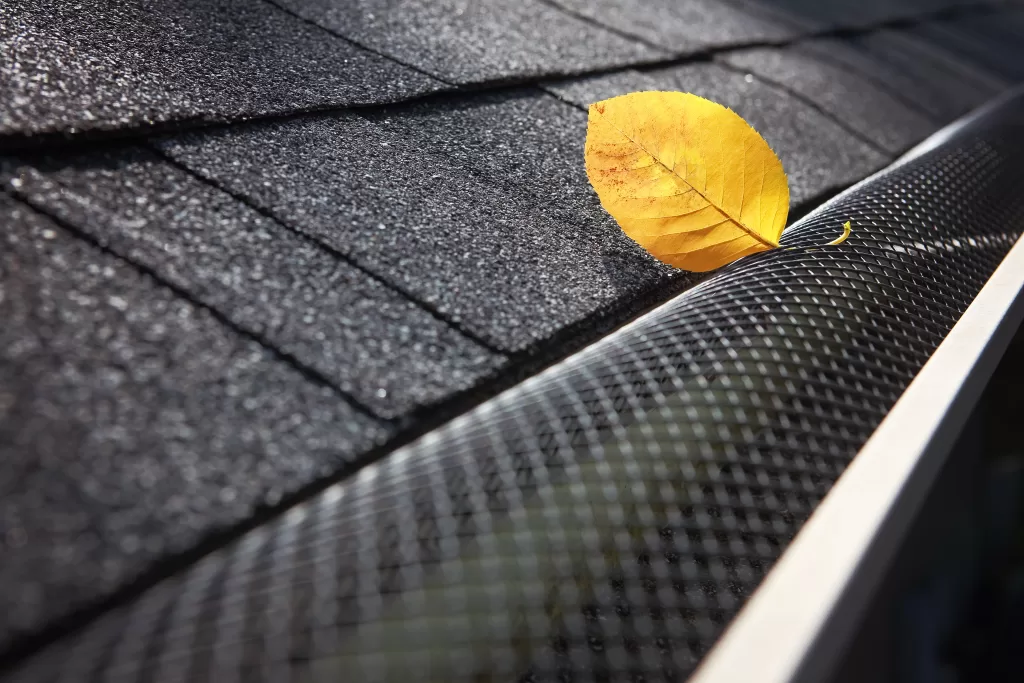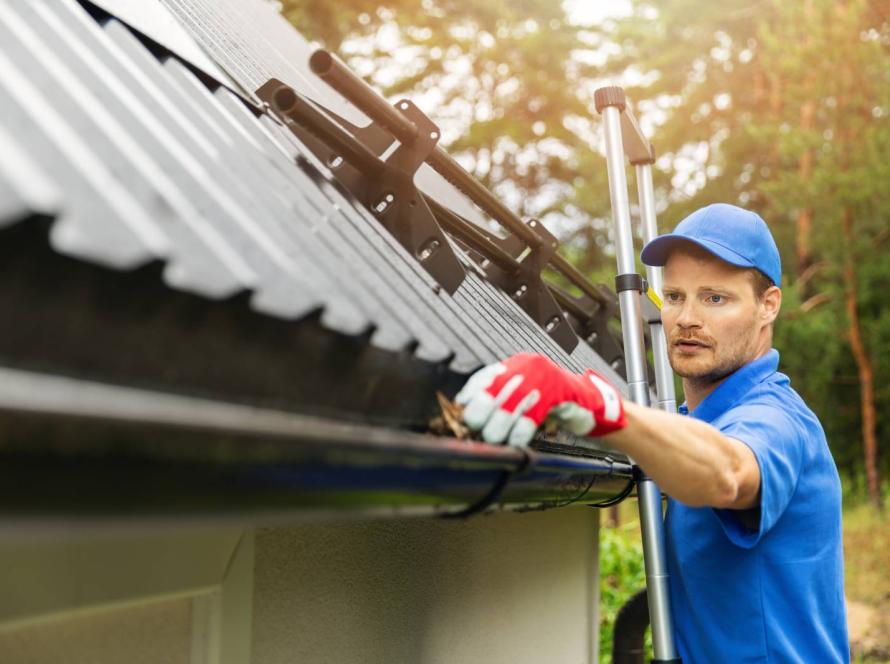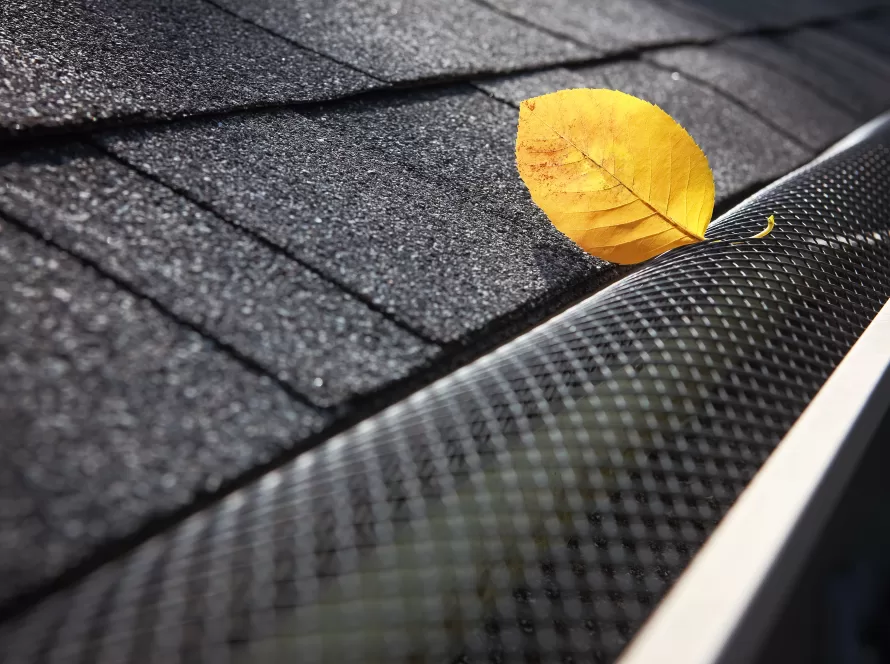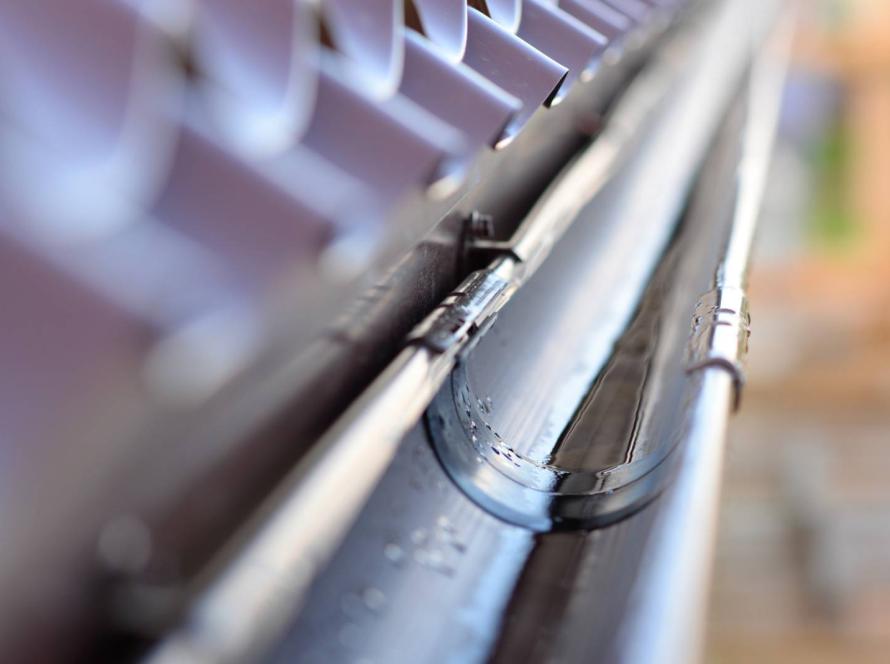Many things about homeownership come with strings attached.
You can’t add on to your home without permission. You can’t install a swimming pool without approval. In most states, you can’t even cut a hole in the side of your home for a new window without pulling a permit.
What you don’t need permission to do is install new gutters. That means you’ll need to worry about one less task before you have a new gutter system installed.
How Gutters Work
Gutters collect rainwater and snowmelt from the roof. While snowmelt might not be a big deal—unless you live in Northern California—during the rainy season, you don’t want to be without a properly working gutter system.
Water goes through the gutters to the ground through downspouts. A downspout ends at the base of the home, so where does the water go next?
A splash block sits under the downspout and diverts water away from the foundation. In some gutter system designs, there is no splash block. Instead, extra tubing attached to the downspout base extends into the yard or on a driveway.
Rain gutters protect your home’s structure from water damage. Later in this article, we’ll look at all the possible scenarios you could deal with if you don’t have a working gutter system.
More About Gutter System Components

You couldn’t have a more straightforward yet vital system protecting your home. The roof is your home’s first line of defense against water damage. Without a robust gutter system, you weaken the roof’s ability to protect your home.
For example, if not cleaned out regularly, leaves and other debris block gutters from diverting water run-off. Once debris builds up, water overflows, resulting in damage to your siding, among other things.
Most downspouts have a downspout elbow attached at the bottom. Set at an angle, the elbow directs water away from your home. A typical minor gutter system repair is a cracked or missing downspout elbow.
Elbows don’t only work at the bottom of a downspout. You’ll see them used at corners and bump-outs as well. Downspout elbows work anywhere there’s an obstacle that could interfere with the downspout’s ability to channel water to the ground.
Gutter systems also include end caps and fascia brackets.
End Cap
The gutter itself fits into a flat piece of metal called an end cap. End caps close off the gutter at the end, preventing debris or water from flowing out of the gutter.
Fascia Bracket
When installing gutters, your installer will mount them to the roof’s edge.
Fascia brackets support the gutter’s trough, which prevents weakening and sagging. The design of these brackets ensures your gutters can withstand the heavy load of water rolling off the roof.
Downspouts also use brackets to keep them stable as water passes through on its way to the ground.
What Type of Gutters Work Best?
Maybe you’re used to seeing vinyl gutters on homes in your neighborhood. Did you know vinyl isn’t the only choice for gutter material? Let’s talk about what type of gutters you can choose from when you’re ready to have your new system installed.
Vinyl
One common material used to construct gutters is vinyl. Homeowners like it because it’s less expensive than the other options.
Aluminum
This is another excellent option for residential gutters. Aluminum is relatively lightweight when compared with other gutter materials. It’s also rust-resistant.
Another advantage of aluminum is that it requires relatively low maintenance.
Copper
If you’re looking for a trendy, decorative material for your gutters, ask your installer about copper. Copper is beautiful, but it’s also highly resistant to corrosion.
The disadvantage to copper gutters is the high cost.
Steel
Steel gutters are durable. Galvanized steel holds up well under harsh weather conditions. The main disadvantage to steel is that it’s prone to rust.
Since vinyl is one of the most popular gutter materials, we’ll discuss the advantages of vinyl gutters next.
More About Vinyl Gutters
We’ve alluded to the ease of installation, but there are other reasons why vinyl gutters are a fan favorite. They include:
Price
Vinyl is the most economical gutter material for budget-minded homeowners—and who isn’t these days. You may pay a little less for installation as well.
Low Maintenance
Vinyl gutters don’t dent or rust. You also don’t need to worry about painting them even if they get scratched. They are a genuine, low-maintenance option.
Of course, even the best materials have a few disadvantages, and vinyl is no different. Here are a few things to consider:
Durability
Vinyl gutters usually last around 8-10 years. The thickness of the vinyl is a determining factor in how long these gutters last. Some last longer than that, and some don’t make it to the 10-year milestone.
Strength
PVC plastic is the primary material in vinyl gutters. If you live in an area that gets a lot of heavy rainfall, some vinyl gutters can’t support the weight of the water. Make sure you explore the option of installing seamless vinyl gutters.
Speaking of installation, how do you install gutters anyway? We’ll talk about that next.
How to Install Gutters
Perhaps you’ve witnessed one of your neighbors installing new gutters. It’s a project many weekend warriors attempt to take on, and frankly, many regret it.
Installing gutters is a complex project.
Sizing gutters correctly is almost an art form. At a minimum, it’s a skill that requires a lot of experience.
The next issue is spacing the brackets. You can’t afford mistakes, or you risk instability once you hang the gutters.
Before you hang the first section, you’ll need to calculate pitch. Calculating pitch correctly presents a challenge, and if you don’t get it right, you may compromise the performance of your gutter system.
Professional installers bring years of experience to the table, and they can back it up with credentials, liability insurance, and warranties.
Why Some Homes Don’t Have Gutters
So, who does the gutter installation? Many roofing companies offer gutter installation as one of their services.
If you’ve visited Florida, you may have noticed many homes there don’t have gutter systems. And it’s not only Florida. Homeowners in other states that don’t receive heavy annual rainfall often don’t have gutters installed.
Just because a home doesn’t have a current gutter system doesn’t mean the house doesn’t need one.
You’ll find homes in a particular area without gutters because of age. Homes built before gutters became common may not have them. The homeowners, over the years, have determined going gutter-free hasn’t created any problems.
Some homes have an extended roof overhang. This can prevent large pools of standing water from collecting near the foundation.
A home located on a steep slope may not need gutters either. Whatever the reasoning, if your current home doesn’t have gutters installed, it’s still good to talk with a professional installer to see if gutters are something you should consider installing.
How Long Can a House Go Without Gutters?
The primary role of gutters is to protect a home from water damage. If you don’t have a gutter system or your gutters are in disrepair, you may wonder how long you can put off repairs.
The answer to this question isn’t complex. In short, you shouldn’t wait to either repair or replace broken or worn-out gutters and their system components.
Avoiding the problem is like gambling with the safety of your home’s structure. How much water damage are you willing to sustain by putting off until tomorrow what you can tackle today?
We mentioned homes with a large roof overhang. Those homes have enough allowance to prevent rainwater from pooling around the house. Even those homes don’t always get enough protection from water damage without installing a gutter system.
If the area where you live receives consistent and, at times, heavy rainfall, you must take care of your gutters. If not, you risk your ability to protect the integrity of your home’s structure.
Next, we’ll address some specific dangers of not having gutters.
What Happens If You Don’t Have Gutters?
Water damage impacts 1 in 50 homeowners each year. At least some of the claims filed with homeowners’ insurance providers are due to water damage caused by faulty gutter systems.
Gutters protect your home from the following:
- Basement flooding
- Damage to the foundation
- Standing water
- Ruined landscaping
- Exterior water damage
Any of these are a significant concern for a homeowner. They become even more of a problem if negligence causes the damage. Most insurance policies include a clause regarding what isn’t covered if a homeowner fails to perform routine maintenance.
Read on for specifics on how gutters protect the various components of your home.
How Broken Gutters Can Damage Your Foundation
A substantial amount of rainwater and snowmelt leeches into the ground. Once the ground is saturated, the flood arrives.
If you’ve noticed water pooling up against your home after heavy rainfall, where do you suppose the water goes if the ground can’t absorb it?
If it reaches the foundation, you’re in trouble.
When you have water damage to your foundation, your home’s entire structure is at risk for:
- Wood rot
- Concrete deterioration
- Premature brick deterioration
- Soil erosion
- Excessive movement in the foundation
These are serious issues that you can avoid by paying attention to your home’s gutter system.
Water Damage to The Exterior of Your Home
Water not collected and redirected by your gutter system must go somewhere. It usually flows up against the siding. Over time, you’ll notice peeling paint, mold growth, and a general run-down appearance to your home’s exterior.
If you have water seepage into your home’s walls, once the weather changes—usually the arrival of summer—the walls dry out, and cracks appear.
Gutters prevent this, making this type of water damage rare even in areas that experience consistent and heavy rainfall.
Gutters Prevent Formation of Standing Water

Rainwater rolls off the roof, falls to the ground, and erodes the soil around your home. Over time, the erosion causes a trough to form around your home’s foundation.
Some homeowners believe the answer lies in filling the trough. They use gravel or soil as a filler. What they don’t realize is this is nothing more than a bandage. They’ll eventually need to fill in the trough again and again.
Aside from erosion, standing water creates the ideal environment for mosquitoes to breed. Mosquito-borne illnesses such as West Nile and Zika virus are prevalent in some areas. Why put out the welcome mat?
A gutter system and proper planning allow rainwater to drain correctly. Both will prevent dangerous standing water in the first place.
Gutters and Landscaping
Have you invested in landscaping? If so, your home likely looks beautiful and inviting from the outside. Landscaping contributes to curb value!
All that work could go to waste if the gutter system for your home is subpar or non-existent.
If you have flower beds and shrubs that nestle the perimeter of your house, your gutters help protect them.
One heavy rainfall could destroy your landscaping. Rainwater could wash away your plants and flowers with little effort.
Your landscaping doesn’t make your home look attractive. It also protects your home from flooding. The shrubs you plant bear the brunt of the force of water rolling off the roof during heavy downfall.
Once rainwater destroys the landscaping, your yard looks ugly, but one layer of protection for your home disappears.
Now that we’ve identified some of the negatives associated with neglecting your gutters let’s see what taking care of your existing system can do for your home.
How Gutters Can Add Value to Your Home
You’ve seen how ignoring gutter repairs can result in your basement flooding, cracks in the foundation, and other costly problems. Indeed, a sound gutter system can add value to your home!
While it’s true that maintaining your gutters and even installing a new gutter system adds more protection for your home’s structure, that doesn’t necessarily mean you’ll get more money if you sell the house. The protection offered by gutters helps prevent costly repairs, but it doesn’t result in an increased valuation.
Since gutters are one of the systems all banks and home appraisers expect to exist on a home, the fact that you’ve taken care of yours doesn’t impress. Gutters in disrepair have the opposite effect.
A home appraiser will provide the cost-to-cure if your home doesn’t have an adequate gutter system.
Cost-to-cure is a rough estimate of what a buyer would need to pay to install a new system or repair the existing gutters. The appraiser ends up subtracting the cost from your home’s overall value.
What will add to your home’s value is a new roof.
It’s not uncommon to install a new roof and gutters simultaneously. If you need both, you’ll enjoy a decent ROI on the roof and you’ll be one step ahead when you’re ready to sell your home because a home inspector won’t be able to ding you on a broken or worn out gutter system.
Essential Things to Consider When Buying Gutters
Gutters are not a one-size-fits-all type of purchase. When calculating the cost of gutters, you’ll have several things to consider, including:
Type of Gutters
We already mentioned that vinyl gutters cost less than all the other materials. Steel and copper will likely be the most expensive.
Height of Rooflines
The higher the rooflines, the more expensive the job.
Distance
Longer spans cost more
Home Design
Your home’s layout impacts the cost of gutters. Gutters installed on simple home designs with fewer rooflines cost less.
Another factor to consider is gutter guards, also called leaf guards. Most contractors offer these as an add-on. Gutter guards provide extra protection for your gutter system and help reduce maintenance.
Your zip code also determines your cost. The cost of materials and labor vary throughout the country.
Generally, the average cost to install aluminum gutters is around $4 to $9 per foot. Vinyl gutters run approximately $3 to $5 per foot.
What About Gutter Maintenance?
Once you’ve installed new gutters, you’ll want to make sure you keep up with maintenance. Gutter maintenance includes regular cleaning and inspections.
Most experts recommend cleaning gutters twice a year. Once in the autumn after the leaves drop, and at the end of spring.
It’s essential to avoid a buildup of leaves and other debris in the gutters. It interferes with the way your gutters channel rainwater, but it also adds extra weight to the gutter troughs.
You can manually remove debris. It takes sturdy gloves, a garden hose, and a ladder. However, if you’re not comfortable on a ladder, you can find companies specializing in gutter maintenance.
The gutter guards we mentioned earlier? Installing them can help prevent debris from clogging gutters and downspouts. They’re an extra investment, but it could be worthwhile to ask your gutter installer about adding guards to your project.
If you can do it safely, use a ladder and inspect gutters at least yearly.
Tips on Repairing Damaged Gutters
You may wonder if there’s any hope for a damaged gutter. The good news? You may be able to repair a broken gutter and get a little more life out of it before you need a replacement.
Common DIY gutter repairs include:
Patching a Hole
Steel gutters are susceptible to rust. Copper and aluminum gutters can fall victim to sharp tools and falling branches. The key to successfully patching holes is not to let the hole get too big.
You’ll need roofing cement and a metal patch that matches the gutter material to patch a hole in your gutter.
Repairing a Leaky Joint
If you’ve noticed rainwater dripping from a gutter, it’s probably developed failure at the joint. Over time, the joints between lengths of gutter can fail. When you inspect the leak, you may find a missing seal—a relatively simple repair.
It’s also possible that you’ll need to replace a piece of gutter or the joint.
Curing Sagging Gutters
Gutters can sag when they wear out or when an anchoring spike pulls loose. If that happens, and you don’t take care of it, you may discover the gutter on the ground.
To successfully repair a sagging gutter, you should replace the spike with a 7-inch-long gutter screw.
Many homeowners can handle these repairs, but if you don’t feel safe on ladders or you’d rather have an expert take care of things, you can always call a roofing company or gutter installation contractor.
We Take Care of All Gutter Installation

Compare Quotes from Top-rated Gutter contractors in your area.
I hope this guide provides more understanding of your gutter system and what needs to be done to keep your gutters in tip-top shape.
If you still have questions or would like to talk with an expert, our Gutter Professionals are here to help. Tap here to get a free quote for gutter repair and replacement.





Facebook
Comments